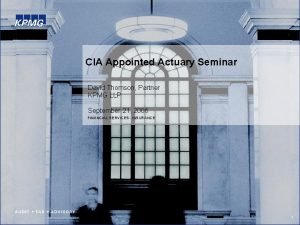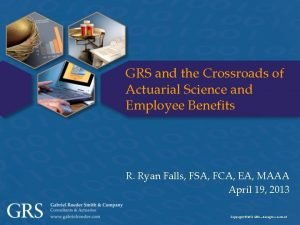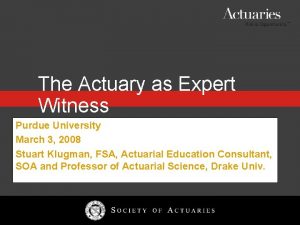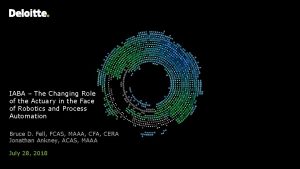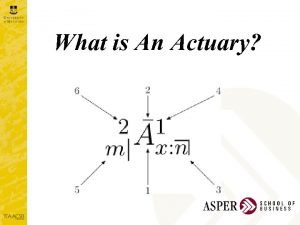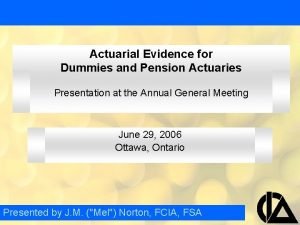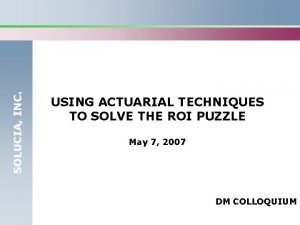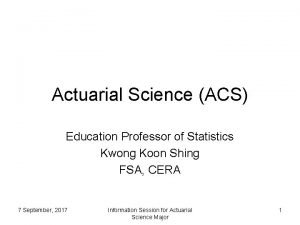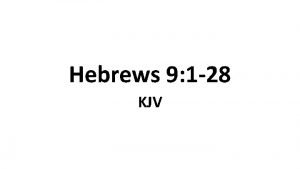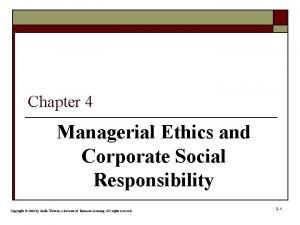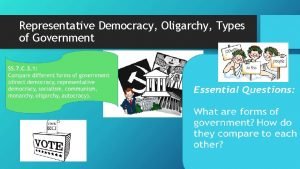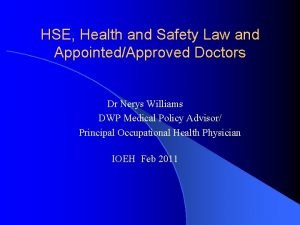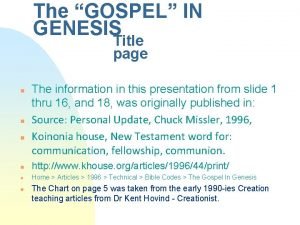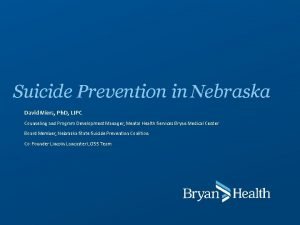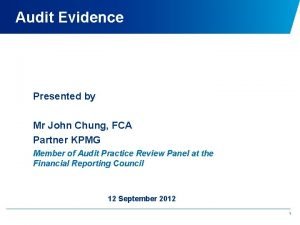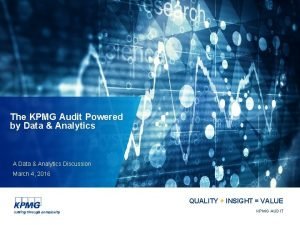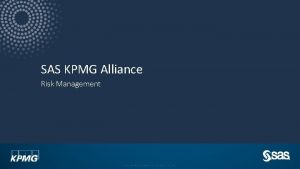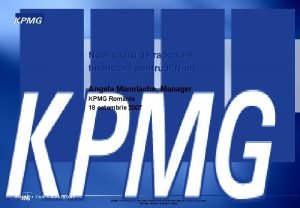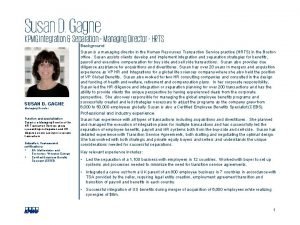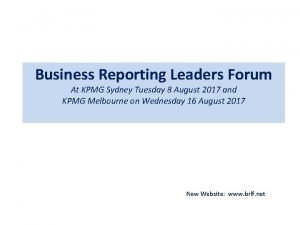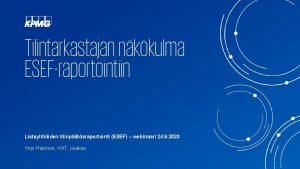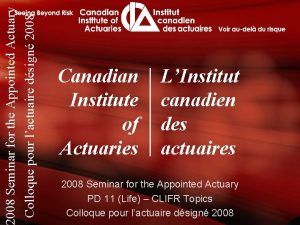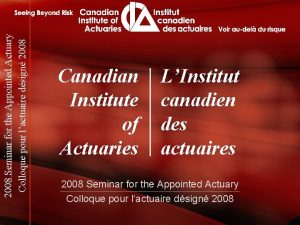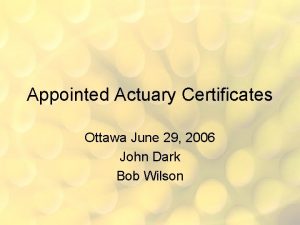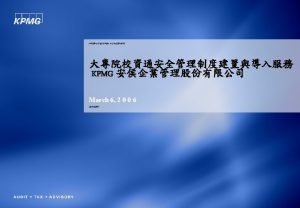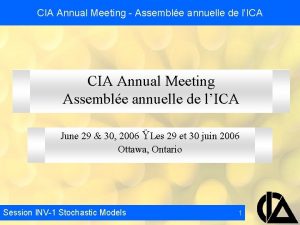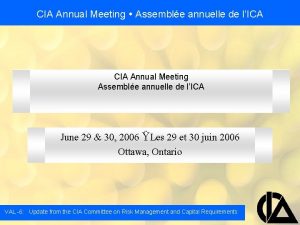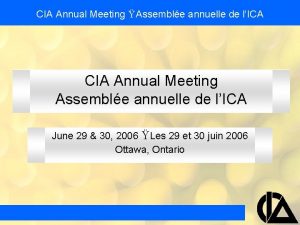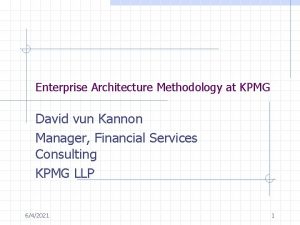CIA Appointed Actuary Seminar David Thomson Partner KPMG
































- Slides: 32

CIA Appointed Actuary Seminar David Thomson, Partner KPMG LLP September 21, 2006 FINANCIAL SERVICES - INSURANCE 1

Today’s Agenda Background What Are The Changes Practical Application Issues Impact On Financial Reporting 2

Background Global trend towards international financial reporting standards (“IFRS”) Canadian Ac. SB has announced a plan to move to IFRS within 5 years No more Canadian GAAP Convergence underway IFRS accounting model is a fair value measurement model Most relevant measure 3

What Are The Changes 3 new accounting standards S. 3855 Financial Instruments – Recognition and Measurement S. 3865 Hedges S. 1530 Comprehensive Income Consequential amendments S. 4211 Replaces S. 4210 – Life Insurance Enterprises Ac. G 9 Financial Reporting by Life Insurance Enterprises 4

What Are The Changes Applies to all entities Affects the life insurance industry in a unique way due to linkage between asset and liability measurement Extensive lobbying for an exemption for life insurers however CICA unconvinced The Train Has Left The Station!! Will significantly change the measurement of financial instruments and their presentation and disclosure of the financial statements. 5

What Are The Changes Timing Applies to fiscal years beginning on or after October 1, 2006 for publicly accountable enterprises Q 1 2007 for most life insurers 6

What Are The Changes Transition No restatement of prior periods Designate all assets/liabilities at beginning of first period Generally January 1, 2007 Restate the opening balance sheet To recognize assets/liabilities at fair value To write-off previously deferred gains/losses Adjust opening equity as a result of the above 7

What Are The Changes Application All financial assets and liabilities that meet the definition Insurance contract liabilities meet the definition however, they are specifically exempted therefore 4210/4211 measurement basis continues i. e. CALM Results in a “Hybrid” or mixed measurement model 8

CICA 3865 - Hedges Combines existing guidance in Ac. G-13 on when an entity can apply hedge accounting with guidance on how to apply hedge accounting Introduces to Canadian GAAP three types of hedges: Fair value hedge, cash flow hedge and hedge of a net investment in a self sustaining foreign operation and provides guidance on how to account for each New requirement that any ineffectiveness in a hedging relationship be recorded immediately in income Significant disclosure requirements 9

Hedge Accounting S. 3865 Current GAAP Hedge is measured on the same basis as the hedged item Otherwise derivatives are measured as equities → moving to market GAAP in 2007 Derivatives measured at fair value Unrealized gains/losses to income for fair value hedges For cash flow or net investment hedges, effective portion of unrealized gains/losses is reported in other comprehensive income and the ineffective portion in income 10

Comprehensive Income – S. 1530 Comprehensive income. . change in equity of an enterprise during a period from transactions and other events and circumstances from non-owner sources. It includes all changes in equity except those resulting from investments by owners and distributions to owners Other comprehensive income (OCI). . revenue, expenses, gains or losses that are included in comprehensive income, but excluded from net income 11

Comprehensive Income - S. 1530 Statement of comprehensive income must be displayed with same prominence as other financial statements OCI is a temporary “parking lot” for certain gains and losses arising from certain hedges, translation of selfsustaining foreign operations and available for sale financial assets OCI items are also tax-effected Amounts in OCI reclassified to net income when required by GAAP 12

CICA 4211 – Life Insurance Enterprises Replaces the existing CICA 4210, effective immediately with the implementation of CICA 3855, to conform to the latter Deletes the old “move to market” accounting for assets that are financial instruments but retains it for “life insurance investments”, defined as: “ investments held by life insurance enterprises, other than: (a) investments in subsidiaries, joint ventures, partnerships or companies that are subject to significant influence by the investor; and (b) financial instruments and non-financial derivatives” What does this leave on a move to market basis? Most common example is investment real estate 13

Classification • All financial instruments must be classified • Hold To Maturity • Held For Trading • Available For Sale • Loans and receivables • • Once and for all designation at inception Based on management’s intention 14

Classification Category Held To Maturity Accounting Treatment Amortized Cost Issues Portfolio Tainting Rules - Difficult to maintain Requires reclassification to AFS Held For Trading Available For Sale Loans and receivables Fair value with gains and Can elect HFT for any losses included in income financial instrument at inception (The Fair Value Option) Fair value with unrealized Mismatch for assets gains and losses included backing liabilities in Other Comprehensive Income. Amortization of premiums/discounts included in income. Amortized cost 15

Classification $ Net income X Other comprehensive income X Total comprehensive income X → Income will be accounted for differently depending on the classification → OCI is a separate category within equity on the balance sheet WILL LIKELY CHANGE THE FOCAL POINT FOR INVESTORS AND ANALYSTS 16

Classification Net Income Investment Portfolio Other Comprehensive Income Hold To Maturity Amortized Cost Held For Trading Change in fair Nil value Amortized cost Change in fair plus realized gains value Available for Sale Nil 17

Classification Held to Maturity Held for Trading Available for Sale Net Income Other Actuarial Liabilities Comprehensive Discount Rate Income Amortization Nil Book Matched Change in fair value Amortization Nil Market Matched Change in fair value Market Mismatched 18

Applying Financial Instruments to Life Insurers – impact on policy liability measurement Under CALM, policy liabilities would reflect the carrying value of assets used to support liabilities If available for sale (AFS) assets support liabilities, a mis-match arises since: unrealized gains are held in other comprehensive income (OCI), while the corresponding increase in policy liabilities are expensed Hold to maturity classification ordinarily won’t be sustainable for investment portfolios 19

Applying Financial Instruments to Life Insurers – impact on policy liability measurement This leaves the “fair value option”, ie. as held for trading: Ø Avoids mis-matches as all investment gains, realized and unrealized, would be recognized in income in the same period as changes in policy liabilities Ø Assets supporting surplus can be either on an AFS basis (probably the most common approach) or at market Ø This will likely be the preferred option for most life insurers 20

Practical Application Designation as trading/use of fair value option for asset backing liabilities Ø Theoretical matching with CALM liability model Ø Eliminated income statement volatility However, there are significant practical application challenges Ø Controls and procedures within the actuarial valuation prices Ø Au. G-43 compliance Ø Difficulty with rollforward techniques when CALM valuation is done pre-period end Ø Will require new controls and procedures 21

Applying Financial Instruments to Life Insurers – Determining Fair Value Active market valuation Non-active market Ø Ø Ø Published prices Valuation models/techniques External evidence vs. internal analysis Major Concern for OSFI is reliability 22

OSFI guideline D-10 limits use of the “fair value option” Only if the result is “more relevant financial information”, where it: Ø Eliminates or significantly reduces measurement or recognition inconsistencies (“accounting mismatch”) Group of financial assets and/or liabilities managed and performance Ø evaluated on a fair value basis General requirements: Both of the above requires documented risk management strategy FV option should not be used for any assets for which fair values cannot be reliably estimated FV option should not be used for loans and mortgages to individuals, or to companies with revenue under $62. 5 M Assets backing policy liabilities would meet this criterion – but not surplus assets Not clear whether this would have application for most insurers 23

Applying Financial Instruments to Life Insurers – use of the “fair value option” Note for those with US reporting requirements - the “fair value option” is available under both Canadian GAAP and International Financial Reporting Standards (IFRS), but not under current US GAAP Ø However, proposals were released recently to change US GAAP to allow the fair value option 24

Applying Financial Instruments to Life Insurers Asset/Liability Investments financial Investments – real estate Loans and receivables Policy liabilities Deferred realized investment gains Other liabilities Expected accounting basis Backing policy liabilities Backing surplus Held for trading Available for sale Amortize to market (current basis) Amortized cost Exempt from CICA 3855; CALM valuation No longer applicable to financial instruments – realized gains included in income Amortized cost 25

Implementation issues – systems and processes Continue to amortize purchase premiums and discounts for fixed income securities (constant yield method) Need this in particular for AFS securities, otherwise premiums and discounts would not be “realized” until sale or maturity, distorting income New rules call for use of bid prices rather than “last trade” prices as market values 26

Implementation Issues – Treatment for Tax Purposes Mark to market property (for tax) includes: An SDO (Specified Debt Obligation) which is carried at market in the books and Has been carried at market since the time it was purchased Appears that all SDO’s currently held (at Dec 31, 2006) will not be MTM property for tax purposes Many investments will eventually become MTM properties (AFS and HTM classifications) 27

Implementation Issues – Treatment for Tax Purposes Tax Reserves P&C reserves – Will change due to change in book reserves Life reserves Pre-96 – No change as a result of change in book reserves Life reserves Post-95 – Will change due to change in book reserves Question: How direct is the relationship to FV increase? 28

Implementation Issues – Treatment for Tax Purposes Result: There will be a change in book and tax reserves (except life pre-96 tax) The related change in SDO’s currently owned will not trigger a taxable income inclusion Finance will not like a one time increase in reserves with no immediate income inclusion on SDO’s Transitional rule for reserve increase? Over what period? Impact on Future Tax discount adjustment included in actuarial reserves 29

Implementation issues – systems and processes, cont’d Investments will need to be “tagged” for different categories For AFS assets, will need both fair value and cost (to calculate realized gains, and to relieve OCI) Assess how the fair value of any financial instruments for which a quoted market price is not available will be accurately determined for reporting purposes 30

Implementation issues – reporting timetables Without the “asset value smoothing” in the old CICA 4210, asset carrying values will be much more volatile Actuarial liability calculations will have to reflect asset value movements right up to year end, to avoid mismatches Ø Ø Re-run or run actuarial calculations only after year end? Develop methods for bulk adjustments to liabilities based on late-in-year asset movements? 31

Impact on financial reporting Earnings Volatility should not change much for assets backing insurance liabilities… … but will increase sharply for assets backing surplus Some loss of comparability with pre-2006 results Higher book values Higher asset values Higher total surplus - will mean lower ROEs Asset carrying values should be more easily understood by readers … but policy liabilities will be just as opaque as ever 32
 Cia actuary
Cia actuary Counjury
Counjury Actuary expert witness
Actuary expert witness Iaba actuary
Iaba actuary What does an actuary do
What does an actuary do Valerie du preez
Valerie du preez Actuarial evidence
Actuarial evidence Actuary pictures
Actuary pictures Mgmt 310 purdue
Mgmt 310 purdue Ian duncan actuary
Ian duncan actuary Smu actuarial science
Smu actuarial science Sherry chan actuary
Sherry chan actuary Mindguards
Mindguards It is appointed unto man once to die
It is appointed unto man once to die It is appointed unto man once to die kjv
It is appointed unto man once to die kjv Managerial ethics and corporate social responsibility
Managerial ethics and corporate social responsibility A self appointed council amends the country's constitution
A self appointed council amends the country's constitution Mudaliar committee
Mudaliar committee Hse appointed doctors
Hse appointed doctors Man appointed mortal sorrow
Man appointed mortal sorrow Wordsworth appointed poet laureate
Wordsworth appointed poet laureate David miers partner
David miers partner John chung kpmg
John chung kpmg External data
External data Kpmg
Kpmg Plan de conturi kpmg
Plan de conturi kpmg Kpmg integration and separation
Kpmg integration and separation Dr nick stragalinos
Dr nick stragalinos Mang long
Mang long Kpmg directors toolkit
Kpmg directors toolkit Virpi halonen kpmg
Virpi halonen kpmg Pml kpmg
Pml kpmg Kpmg innovation challenge
Kpmg innovation challenge
